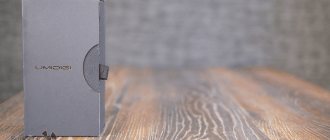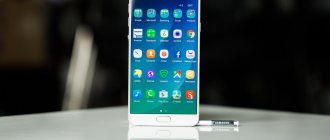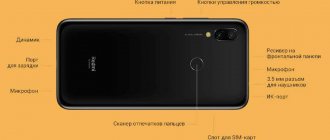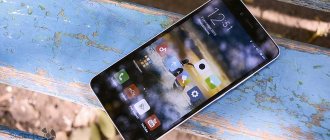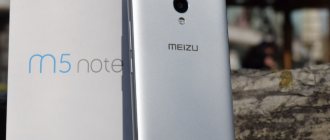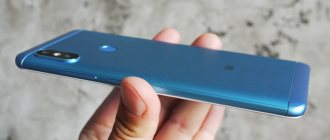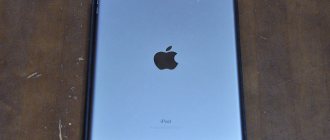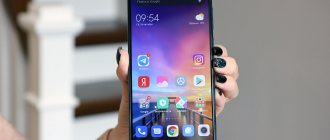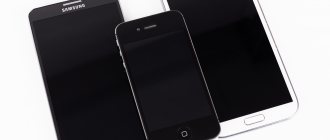UMIDIGI C NOTE results in AnTutu Benchmark
In the popular AnTuTu benchmark, the UMIDIGI C NOTE smartphone scores an average of about 42,000 points. This figure, like all those given below, was taken from the official website of the developer of this software. Unfortunately, we currently do not have detailed data on the device's performance in AnTutu.
Comparison with other smartphones from the ratings of different years
| Model | Platform | Memory | CPU rating | UX assessment | 3D assessment | Overall rating | |
| 1 | Samsung Galaxy S7 Edge (SM-G935T) | Snapdragon 820 | 4 Gb + 32 Gb | 26043 | 43398 | 54343 | 132304 |
| 2 | ZTE Nubia Z11 | Snapdragon 820 | 6 Gb + 64 Gb | 30823 | 32093 | 58179 | 131770 |
| 3 | Samsung Galaxy S7 Edge (SM-G935V) | Snapdragon 820 | 4 Gb + 32 Gb | 25151 | 43288 | 53915 | 130961 |
| 4 | Huawei Mate 9 Pro | Kirin 960 | 6 Gb + 128 Gb | 32506 | 44230 | 42376 | 129677 |
| 5 | Sony Xperia X Performance | Snapdragon 820 | 3 Gb + 32 Gb | 27578 | 36602 | 54177 | 126543 |
| 6 | Huawei P9 | Kirin 955 | 3 Gb + 32 Gb | 34516 | 36516 | 17665 | 94117 |
| 7 | Huawei P9 Plus | Kirin 955 | 4 Gb + 32 Gb | 33461 | 36761 | 17429 | 93896 |
| 8 | Huawei Honor 8 | Kirin 950 | 4 Gb + 32 Gb | 32413 | 35319 | 18420 | 92348 |
| 9 | Apple iPhone 6 Plus | Apple A8 | 1 Gb + 128 Gb | 27006 | 24266 | 24882 | 83289 |
| 10 | Apple iPhone 6 | Apple A8 | 1 Gb + 32 Gb | 43319 | 23454 | 12348 | 79230 |
| 11 | UMIDIGI C NOTE | Mediatek MT6737T | 3 Gb + 32 Gb | 42000 |
The rating of devices on the official AnTuTu website is updated once a month. Old data is available via Web Archive.
Top
UMiDIGI C Note (CNOTE) technical specifications
Brand UMiDIGI Name C Note Type CNOTE Rating Launch 2017
Body
Weight 172 g Dimensions 154.7 x 76.6 x 8.4 mm Colors gold gray SIM type Nano SIM
System
UMiDIGI C Note runs on Android OS v7.0 (Nougat) out of the box, but the C Note firmware can be upgraded to a newer OS version.
OS Android OS v7.0 (Nougat) Chipset Mediatek MT6737T CPU Quad-core 1.5 GHz Cortex-A53 GPU Mali-T720 MP2
Display
Screen size is measured in inches, diagonally from corner to corner. 5.5-inch IGZO capacitive touch screen with a resolution of 1080 x 1920 px supports multi-touch technology.
IGZO technology Size 5.5 inches Resolution 1080 x 1920 px Multi-touch yes
Memory
The smartphone's memory (3 GB) cannot be expanded, but the memory (32 GB) can be expanded using a microSD card.
MEMORY 3 GB Internal storage 32 GB External storage microSD
Camera
The UMiDIGI C Note camera is equipped with autofocus. Autofocus is a camera feature that fine-tunes the focus of the camera and is a nice feature of this smartphone.
Front camera 5 MP Rear camera 13 MP 4160 x 3120 px autofocus LED flash
Connection
C Note supports 3G and 4G. This smartphone has a built-in GPS receiver. GPS is a satellite navigation system that allows you to determine your exact geographic location on Earth. This UMiDIGI smartphone has an FM radio.
GSM 850 / 900 / 1800 / 1900 Mobile network 2G / 3G / 4G WLAN Wi-Fi 802.11 a/b/g/n Bluetooth v4.1, A2DP GPS A-GPS NFC no FM radio yes USB microUSB 2.0 Audio 3.5 mm jack
Battery
Li-Po 3800 mAh battery, non-removable gives the smartphone a good battery reserve.
Type Li-Po 3800 mAh, non-removable
Peculiarities
Smartphone sensors measure physical quantities and transmit them to the application processor. Phones' accelerometer is a built-in electronic component that measures tilt and movement. A fingerprint sensor is one of the easiest and most secure ways to protect your smartphone. The proximity sensor detects when a user is holding the phone close to their face during a call and turns off the display to prevent keypresses and draining battery from the display. The C Note has a Dual SIM feature, which means you can insert two different SIM cards and use them both from the same phone.
Sensors accelerometer compass fingerprint gyroscope hall light proximity special Dragontrail glass Dual SIM
Compare UMiDIGI C Note with other mobile phones
The above specifications are based on official data published by the manufacturer, but we also take into account user reviews. If you find a bug or something wrong in the above specifications for UMiDIGI C Note, please feel free to report the issue to us.
Characteristics of UMIDIGI C NOTE in detail
Platform
Chipset Mediatek MT6737T Quad core CPU 4 x ARM Cortex-A53 @ 1.50 GHz 64-bit Yes GPU ARM Mali-T720 MP2 @ 600 MHz NPU No Process technology 28 nm
Memory
RAM 3 Gb - LPDDR3 @ 733 MHz (Single Channel) Built-in storage 32 Gb - eMMC 5.0 Memory expansion Yes Memory card types microSD, microSDHC, microSDXC Maximum capacity 256 Gb Dedicated slot No data
Screen
Resolution 1080 x 1920 (FullHD) Aspect ratio 9:16 Matrix type IPS Diagonal 5.5″ Area ~83.4 cm2 Fill percentage ~70.4% (of the total front surface area) Pixel density ~401 ppi Security Yes
Connection
Communication standards GSM, UMTS, LTE 2G GSM 850/900/1800/1900 MHz 3G UMTS 900/2100 MHz 4G LTE FDD-LTE 800/1800/2100/2600 MHz, TD-LTE B38/B39/B40/41 LTE support Yes LTE categories Category-4 LTE speed Up to 150 Mbps in data download mode, up to 50 Mbps in upload mode LTE device categories indicate the maximum speed at which it can send and receive data in 4G LTE networks due to carrier aggregation . Number of SIM cards 2 Type of SIM cards Nano SIM
Cameras
Main camera
Type Single Resolution 13.0 MP Autofocus Yes Aperture No data Flash LED
Front-camera
Resolution 5.0 MP Aperture No data
Interfaces
WiFi IEEE 802.11 a/b/g/n, 2.4 GHz, Wi-Fi Direct, DLNA, Wi-Fi access point mode is a technology for building wireless local networks based on the IEEE 802.11 family of standards. Supported by all modern smartphones and many mobile phones. Bluetooth v4.1 Bluetooth is a universal wireless interface for exchanging data between various types of devices at close range. Can be used for file transfer, audio streaming, network connection, printing and other purposes. The newer the version, the greater the speed and number of supported profiles. Navigation GPS, A-GPS, GLONASS For at least 10 years, smartphones have supported the geolocation function using data from satellite navigation systems. At the moment, these are the American-developed GPS, the Russian GLONASS, the Chinese BeiDou and the European GALILEO. As a rule, smartphones support the first two and optionally the rest. NFC No The built-in NFC module of a smartphone is mainly used for contactless payment in applications like Google Pay and Samsung Pay. Can also be used to read data from contactless cards, transfer files, etc. Read more here. Infrared port No Some smartphones have a built-in IR port. In the past, it was used to synchronize data both between two mobile phones and between a phone and a PC. However, now, due to its low speed, the infrared port is used mainly to control external devices in remote control mode. FM radio No Built-in radio receiver that allows you to listen to radio stations operating in the FM range. In most cases, it only works when headphones are connected, since the wire is used as a communication antenna. However, there are devices with a built-in antenna. 3.5 mm audio No Standard audio jack for connecting wired headsets and headphones. Starting in 2020, some smartphone manufacturers, following Apple, began to abandon it. In this case, to connect regular headphones, you need a special adapter for Lightning/USB Type-C. USB Micro USB, On-The-Go The type of USB connector installed in the smartphone and the capabilities it supports.
Sensors and biometrics
Sensors Accelerometer Fingerprint scanner No Face scanner (Face ID) No Iris scanner (IRIS) No
Power supply
Battery capacity 3800 mAh Battery voltage 4.4 V Battery type Li-ion Removable battery No Fast charging No Wireless charging No
Software
Operating system Android 7.0 Nougat Shell No Over-the-air (OTA) update Yes Sending messages SMS, MMS, Email, Push Email, IM Internet browser HTML5, CSS, JavaScript Audio formats AMR Video formats 3GP Graphic formats BMP Voice assistant Google Assistant
Physical parameters
Dimensions 154.7 x 76.6 x 8.4 mm Weight 172 g Package dimensions 173.5 x 170.0 x 71.5 mm Package weight 456 g Protection class No Colors Golden, Gray
Performance
Geekbench 662 / 1769 (Single core / Multi core) UMIDIGI C NOTE performance rating according to the popular GeekBench benchmark.
Average data are shown. AnTuTu 42000 points Performance assessment of UMIDIGI C NOTE according to the popular AnTuTu benchmark. Average data are shown. PassMark 3687 / 75215 (PassMark Rating / CPUMark Rating) Performance evaluation of UMIDIGI C NOTE according to the popular PassMark benchmark. Important note : unfortunately, we cannot guarantee 100% accuracy of all data presented on this page, but we are constantly working in this direction. If you notice an error in the device settings, we will be very grateful if you report it in the comments.
Top
Smartphone Umidigi C Note
Affordable model with high-quality screen and all-metal body
Content
- Specifications
- Equipment
- Appearance and ease of use
- Screen
- Camera
- Telephone and communications
- Software and multimedia
- Performance
- Thermal photographs
- Playing video
- Battery life
- Bottom line
Last spring, the Chinese company Umidigi (formerly Umi) released its next new product called C Note. The smartphone is attractive for its affordable price and good characteristics for such a price - at least that’s what it looks like at first glance. But whether the budget new product actually meets all the declared characteristics, you will find out from our new review of the smartphone called Umidigi C Note.
Main characteristics of Umidigi C Note
- SoC MediaTek MT6737T, 4 cores ARM Cortex-A53 @1.44 GHz
- GPU Mali-T720 (MP2, 600 MHz)
- Operating system Android 7.0
- Touch display IPS 5.5″, 1920×1080, 401 ppi
- Random access memory (RAM) 3 GB, internal memory 32 GB
- Nano-SIM support (2 pcs.)
- MicroSD support up to 256 GB
- GSM/GPRS/EDGE networks (850/900/1800/1900 MHz)
- WCDMA/HSPA+ networks (900/2100 MHz)
- LTE Cat.4 FDD networks (B1/3/7/20)
- Wi-Fi 802.11a/b/g/n (2.4 and 5 GHz)
- Bluetooth 4.1
- GPS, A-GPS, Glonass
- Micro-USB, USB OTG
- Main camera 13 MP, f/2.2, autofocus, 1080p video
- Front camera 5 MP, f/2.8, fixed. focus
- Proximity sensor, lighting sensor, accelerometer, compass
- Battery 3800 mAh
- Dimensions 155×77×8.3 mm
- Weight 172 g
Contents of delivery
The Umidigi C Note comes in a large box with a rustic design. The cardboard base, which serves as a tray, is pushed inside the casing, and the whole thing is covered with a dust jacket made of thinner cardboard.
The kit consists of a brightly colored connecting cable, a not very powerful network adapter with an output current of 1 A and a voltage of 5 V, as well as a protective film for the screen, a tool for removing SIM cards and a flexible transparent protective case. Regarding the case, it is worth noting separately that this is a rare case when the smartphone becomes more slippery with the case than without it. In principle, a good-quality metal case with a matte surface does not particularly need a case.
Appearance and ease of use
Umidigi C Note not only looks nice, but also quite decent for its level, and maybe even more expensive than it is. A strong all-metal body without plastic inserts gives confidence in reliability and durability, and the design is neat and does not evoke negative emotions.
The smartphone is quite large, thick and heavy, but thanks to its strongly rounded corners and side edges, it fits quite comfortably in clothing pockets. None of the elements protrude beyond the body, the device is smooth and streamlined, like a piece of soap.
At the same time, Umidigi C Note, as we have already noted, is surprisingly non-slip. It seems that the case is made of the usual matte metal, but still the processing makes the difference, and this smartphone fits perfectly in the hand, does not slip at all, and does not try to fall out on the floor. In addition, there are practically no fingerprints left on its matte surfaces; the smartphone looks neat for a long time.
SIM cards are inserted into a single hybrid slot on the side, which can accept either two Nano-SIM cards or a microSD memory card instead of one of them. It is worth noting here that our test sample had a technical flaw: the sled did not fit into its nest smoothly the first time, we had to adjust the lid each time and refit it again.
The camera module with a dual flash of multi-colored LEDs does not protrude beyond the rear wall of the case. The device lies stable on a hard surface and does not wobble when you touch the screen. Given the front location of the fingerprint scanner, it is convenient to work with the smartphone lying on the table. The flashlight shines brightly.
The front panel is covered with protective 2.5D glass with sloping edges. Thanks to this, the smartphone body as a whole has a finished, streamlined shape. Sensors are installed above the screen as usual, and there is also an LED event indicator.
At the bottom there are three touch buttons, one of which is equipped with a fingerprint sensor. The central button with an integrated fingerprint scanner is not mechanical and cannot be pressed (it's just a recess in the glass). However, this is a touch button, a short touch of which opens the home screen, and a long touch opens the list of running programs. The buttons on the sides perform the functions of returning to the previous screen and setting up desktops. Touch buttons can be disabled and only their on-screen counterparts can be used, which can be configured to your liking in the system settings.
The side buttons do not differ in texture; they are both smooth. The keys have a soft stroke, are easy to feel blindly, in general there are no complaints about them.
The universal Micro-USB connector at the bottom supports connecting external devices in USB OTG mode. Behind the row of holes to the right is a speaker, and behind the holes on the left is possibly a microphone (although it doesn’t need that many holes).
The top end is given over to a 3.5 mm headphone output jack. There was no auxiliary microphone there, which is a little surprising.
The Umidigi C Note smartphone is available for sale in two color options: gray and gold. The dark gray case has a black front panel under the glass, while the gold case has a white one. This is the most typical option today.
Screen
Umidigi C Note is equipped with an IPS display manufactured by Sharp (IGZO) with physical dimensions of 68x121 mm with a diagonal of 5.5 inches. The resolution is 1920x1080, the pixel density is about 401 ppi. The frame around the screen is not the narrowest: about 4 mm on the sides, 17 mm on the bottom, 16 mm on the top.
You can adjust the display brightness manually or use automatic settings based on the ambient light sensor. The AnTuTu test diagnoses support for only 5 simultaneous multi-touch touches.
A detailed examination using measuring instruments was carried out by the editor of the “Monitors” and “Projectors and TV” sections Alexey Kudryavtsev
. Here is his expert opinion on the screen of the sample under study.
The screen of the Umidigi C Note is slightly lighter (brightness according to photographs is 119 versus 113 for the Nexus 7). The ghosting of reflected objects in the Umidigi C Note screen is very weak, this indicates that there is no air gap between the layers of the screen (more specifically, between the outer glass and the surface of the LCD matrix) (OGS - One Glass Solution type screen). Due to the smaller number of boundaries (glass/air type) with very different refractive indices, such screens look better in conditions of intense external illumination, but their repair in the case of cracked external glass is much more expensive, since the entire screen has to be replaced. The outer surface of the screen has a special oleophobic (grease-repellent) coating (better in efficiency than that of the Nexus 7), so fingerprints are removed much more easily and appear at a lower speed than with regular glass.
When manually controlling the brightness and displaying the white field in full screen, the maximum brightness value was about 460 cd/m², the minimum was 20 cd/m². The maximum brightness is high, and, given the good anti-glare properties, readability even on a sunny day outdoors should be at a decent level. In complete darkness, the brightness can be reduced to a comfortable value. There is automatic brightness adjustment based on the light sensor (it is located to the right of the front speaker slot). In automatic mode, as external lighting conditions change, the screen brightness both increases and decreases. The operation of this function depends on the position of the brightness adjustment slider. If it is 100%, then in complete darkness the auto-brightness function reduces the brightness to 160 cd/m² (too bright), in an office illuminated by artificial light (about 550 lux) it sets it to 380 cd/m² (also a lot), in a very bright environment (corresponds to lighting on a clear day outdoors, but without direct sunlight - 20,000 lux or a little more) brightness increases to 500 cd/m² (which is even higher than with manual adjustment); if the slider is approximately 50%, then the values are as follows: 16, 210 and 500 cd/m² (suitable values), the slider is at 0% - 2, 35 and 500 cd/m² (the first two values are underestimated, which is logical). It turns out that the auto-brightness function works adequately and to some extent allows the user to customize their work to individual requirements. At any brightness level, there is no significant backlight modulation, so there is no screen flicker.
This smartphone uses an IPS matrix. The microphotographs show a typical IPS subpixel structure:
For comparison, you can see the gallery of microphotographs of screens used in mobile technology.
The screen has good viewing angles without significant color shift even with large viewing deviations from perpendicular to the screen and without inverting shades. For comparison, here are photographs in which identical images are displayed on the screens of the Umidigi C Note and Nexus 7, while the screen brightness is initially set to approximately 200 cd/m², and the color balance on the camera is forcibly switched to 6500 K.
There is a white field perpendicular to the screens:
Note the good uniformity of brightness and color tone of the white field.
And a test picture:
The colors on the Umidigi C Note's screen are clearly oversaturated and the color balance varies slightly between screens.
Now at an angle of approximately 45 degrees to the plane and to the side of the screen:
It can be seen that the colors have not changed much on both screens, but on the Umidigi C Note the contrast has decreased to a greater extent due to the strong brightening of black.
And a white field:
The brightness at an angle of the screens decreased (at least 5 times, based on the difference in shutter speed), and decreased approximately equally. When deviated diagonally, the black field brightens greatly and acquires a reddish tint. The photographs below demonstrate this (the brightness of the white areas in the direction perpendicular to the plane of the screens is the same!):
And from another angle:
When viewed perpendicularly, the uniformity of the black field is poor:
The contrast (approximately in the center of the screen) is high - about 950:1. The response time for the black-white-black transition is 22 ms (12 ms on + 10 ms off). The transition between halftones of gray 25% and 75% (based on the numerical value of the color) and back takes a total of 36 ms. The gamma curve, constructed using 32 points with equal intervals based on the numerical value of the shade of gray, did not reveal any blockage in either the highlights or the shadows. The exponent of the approximating power function is 2.28, which is slightly higher than the standard value of 2.2. In this case, the real gamma curve deviates little from the power-law dependence:
We did not detect the presence of dynamic adjustment of the backlight brightness in accordance with the nature of the displayed image, which is very good.
The color gamut is noticeably wider than sRGB:
Let's look at the spectra:
We have already seen this in the case, for example, of the Sony Xperia Z2 and other mobile devices. Sony indicates that these screens use LEDs with a blue emitter and green and red phosphors (usually a blue emitter and a yellow phosphor), which, in combination with special matrix filters, allows for a wide color gamut. Yes, and the red phosphor apparently uses so-called quantum dots. For a consumer device, a wide color gamut is not an advantage, but a significant disadvantage, since as a result, the colors of images - drawings, photographs and films - oriented to the sRGB space (and the vast majority of them) have an unnatural saturation. This is especially noticeable on recognizable shades, such as skin tones. The result is shown in the photo above.
The balance of shades on the gray scale is average, since the color temperature is not much higher than the standard 6500 K, but the deviation from the blackbody spectrum (ΔE) is above 10, which is considered a bad indicator even for a consumer device. At the same time, color temperature and ΔE change little from hue to hue - this has a positive effect on the visual assessment of color balance. (The darkest areas of the gray scale can be ignored, since color balance there is not very important, and the error in measuring color characteristics at low brightness is large.)
This device has the ability to adjust the color balance using the hue adjustment.
However, any change in the position of this slider leads to an increase in ΔE, which is already too high. It doesn't make much sense to make a correction.
To summarize: the screen has a high maximum brightness and has good anti-glare properties, so the device can be used outdoors even on a sunny summer day without any problems. In complete darkness, the brightness can be reduced to a comfortable level. It is also possible to use a mode with automatic brightness adjustment, which works adequately. The advantages of the screen include an effective oleophobic coating, the absence of air gaps in the layers of the screen and flickering, and high contrast. The disadvantages are poor uniformity of the black field, low stability of black to the deviation of the gaze from perpendicular to the screen plane, and an excessively wide color gamut. Nevertheless, given the importance of characteristics for this particular class of devices, the screen quality can be considered relatively high, although you should prepare for strange and not entirely natural shades in films and photographs.
Camera
The front module of the Umidigi C Note received the familiar 5-megapixel GalaxyCore GC5005 sensor, which this manufacturer now installs in many of its devices, as well as a lens with an f/2.8 aperture and a fixed focus. Naturally, there is a function of decorating a portrait, but in general the quality of the pictures is so simple that no amount of decoration will improve it.
The main camera of the Umidigi C Note uses a Samsung module (S5K3L8) with a 13-megapixel matrix and an f/2.2 aperture lens. There is phase detection autofocus, dual bright flash and an electronic stabilization system for photo and video shooting.
The camera has a fairly convenient and detailed settings menu, there are additional modes, there is a professional manual mode with a choice of photosensitivity values (up to ISO 1600), exposure compensation, white balance, as well as saturation, brightness and contrast. There is an HDR mode and auto detection for scene modes.
The Umidigi C Note camera can shoot video in a maximum resolution of 1080p, no 4K, and has an electronic stabilization function. The image is not very rich, the colors are quite faded. The detailing is also low, the greenery of the grass blends into mush. Nevertheless, the picture is quite clear and sharp, the video sequence is smooth, without jerks. By the way, there are no complaints about the sound recording; the sound is high-quality, clear and loud, without noticeable distortion or extraneous noise, which is surprising, given the lack of an auxiliary microphone for the noise reduction system.
- Video No. 1 (26 MB, 1920× [email protected] fps, H.264, AAC)
- Video No. 2 (15 MB, 1920× [email protected] fps, H.264, AAC)
- Video No. 3 (20 MB, 1920× [email protected] fps, H.264, AAC)
Below are examples of photographs with our comments on quality. Our specialist Anton Soloviev
.
| The license plates of nearby cars are distinguishable. |
| Good sharpness in distant shots. |
| The camera copes with macro photography. |
| There are noticeable areas of blur in the corners of the frame. |
| Not bad sharpness according to plans. |
| Apart from some corners, the text is well done. |
| The strong interference of sharpening is clearly visible in medium and distant plans. |
The camera looks unfinished. Unsharp corners are immediately noticeable, which indicates poor optics and imperfect software processing. At the same time, the sharpness in the central part of the frame is good, but already in the middle plans the program overemphasizes details. The image looks sharp but unnatural. As a result, the camera is suitable only for undemanding documentary or macro photography.
Telephone and communications
The communication capabilities of Umidigi C Note include support for LTE Cat.4 (up to 150 Mbit/s), only 4 LTE FDD frequency bands are supported, but they include all 3 FDD LTE bands of interest to us (band 3, 7, 20). In the urban areas of the Moscow region, the device behaves confidently, the quality of signal reception is not satisfactory, but it was not possible to achieve maximum speeds in wireless networks in familiar test locations.
- GSM 850(B5)/900(B8)/1800(B3)/1900(B2)
- WCDMA 900(B8)/2100(B1)
- LTE FDD 2100(B1)/1800(B3)/2600(B7)/800(B20)
In addition, Umidigi C Note supports both Wi-Fi bands (2.4 and 5 GHz), there are no complaints about the communication quality. The device does not have an NFC module, so the smartphone will not be able to work with travel cards. You can standardly organize a wireless access point via Wi-Fi or Bluetooth 4.1 channels. The Micro-USB connector supports connecting external devices in USB OTG mode. The navigation module works with GPS (with A-GPS), as well as the domestic Glonass. During a cold start, the first GPS satellites are detected within the first tens of seconds, Glonass satellites are “caught” a little later, the positioning accuracy is good. There is also a built-in magnetic field sensor for compass operation in navigation programs.
The phone application supports Smart Dial; settings for sorting and displaying contacts from the phone book are standard for Android. In the conversational dynamics, the voice of a familiar interlocutor is recognizable, but the sound is faded and not very loud. The vibration alert is quite noticeable, there are no complaints about it.
Umidigi C Note does not support both SIM cards in 3G/4G mode at the same time. That is, when one card is assigned to transmit data in 4G, the second one can only work in 2G. The interface allows you to select a specific SIM card for voice calls and SMS in advance. The cards operate in Dual SIM Dual Standby mode, there is only one radio modem.
Software and multimedia
As a software platform, Umidigi C Note uses a relatively recent version of Google Android 7.0 without its own shell. However, a section has been added to the settings that contains some additional improvements, such as LED control, button remapping, screen activation by tapping, and a more advanced than standard power-saving mode with several presets. Among the pre-installed programs, we found a file manager and a music player standard for the MediaTek platform; there are practically no other third-party programs; everything needed here is achieved using Google Apps.
To listen to music, instead of the standard Google Music player, an audio player familiar from other Chinese smartphones on MediaTek is used with BesLoudness settings for the loudspeaker and with presets for the standard equalizer. Both in the headphones and through the speaker, the device sounds dull: the sound volume is not always enough, the sound is not of the highest quality, clear, but not bright or rich, rather muffled and impersonal. There is an FM radio with the ability to record live programs. The built-in voice recorder has average sensitivity and works well.
Performance
The Umidigi C Note hardware platform is based on the MediaTek MT6737T SoC, made using a 28 nm process technology. This is a slightly more advanced modification of the basic MT6737; the configuration of this 64-bit platform includes 4 Cortex-A53 processor cores operating at frequencies up to 1.44 GHz. The Mali-T720 video accelerator with two cores with a frequency of up to 600 MHz is responsible for graphics processing. The RAM capacity is 3 GB and the user storage is 32 GB. Of these, in reality, about 1.9 GB of RAM and approximately 25.5 GB of flash memory are free. It is possible to connect external flash drives in USB OTG mode.
It is possible to expand the memory by installing a microSD card, but to do this you will have to remove one of the SIM cards. You can install applications on the memory card.
MediaTek MT6737 is one of the most modestly capable modern platforms for entry-level mobile devices. It is quite weak in its standard version, as can be clearly seen in the Moto E4 Plus. It was even more unexpected to see how much more powerful the MT6737T version with a higher frequency of processor cores turned out to be. The difference is palpable and noticeable in all tests without exception.
However, it makes no sense to expect particularly high performance from this SoC; the hero of the review demonstrates less than 40K points in AnTuTu. Demanding games and graphics tests sometimes slow down, this is noticeable in the example of the demanding game Mortal Kombat X. Such a device definitely does not have power reserves for the future.
Testing in comprehensive tests AnTuTu and GeekBench:
For convenience, we have compiled all the results we obtained when testing the smartphone in the latest versions of popular benchmarks into tables. The table usually adds several other devices from different segments, also tested on similar latest versions of benchmarks (this is done only for a visual assessment of the obtained dry figures). Unfortunately, within the framework of one comparison it is impossible to present the results from different versions of benchmarks, so many worthy and relevant models remain “behind the scenes” - due to the fact that they once passed the “obstacle course” on previous versions of test programs.
| Umidigi C Note ( MediaTek (MT6737T ) | Moto E4 Plus ( MediaTek (MT6737 ) | Honor 6C (Qualcomm Snapdragon 435) | HTC One X10 (MediaTek Helio P10 (MT6755)) | Honor 8 lite ( HiSilicon Kirin 655 ) | |
| AnTuTu (v6.x) (bigger is better) | 39449 | 30492 | 45579 | 50597 | 57038 |
| GeekBench (v4.x) (bigger is better) | 664/1817 | 558/1569 | 678/2121 | 757/2071 | 809/3357 |
Testing the graphics subsystem in gaming tests 3DMark, GFXBenchmark and Bonsai Benchmark:
When testing in 3DMark, the most powerful smartphones now have the ability to run the application in Unlimited mode, where the rendering resolution is fixed at 720p and VSync is disabled (which can cause the speed to rise above 60 fps).
| Umidigi C Note ( MediaTek (MT6737T ) | Moto E4 Plus ( MediaTek (MT6737 ) | Honor 6C (Qualcomm Snapdragon 435) | HTC One X10 (MediaTek Helio P10 (MT6755)) | Honor 8 lite ( HiSilicon Kirin 655 ) | |
| 3DMark Ice Storm Sling Shot ES 3.1 (bigger is better) | 180 | 99 | 254 | 421 | 398 |
| GFXBenchmark Manhattan ES 3.1 (Onscreen, fps) | 3 | 3 | 11 | 5 | 5 |
| GFXBenchmark Manhattan ES 3.1 (1080p Offscreen, fps) | 3 | 1 | 5 | 5 | 5 |
| GFXBenchmark T-Rex (Onscreen, fps) | 11 | 11 | 28 | 17 | 19 |
| GFXBenchmark T-Rex (1080p Offscreen, fps) | 11 | 6 | 16 | 17 | 18 |
Browser cross-platform tests:
As for benchmarks for assessing the speed of the javascript engine, you should always make allowance for the fact that their results significantly depend on the browser in which they are launched, so the comparison can only be truly correct on the same OS and browsers, and this is possible during testing not always. For Android OS, we always try to use Google Chrome.
| Umidigi C Note ( MediaTek (MT6737T ) | Moto E4 Plus ( MediaTek (MT6737 ) | Honor 6C (Qualcomm Snapdragon 435) | HTC One X10 (MediaTek Helio P10 (MT6755)) | Honor 8 lite ( HiSilicon Kirin 655 ) | |
| Mozilla Kraken (ms, less is better) | 10746 | 16478 | 11038 | 9992 | 8663 |
| Google Octane 2 (bigger is better) | 3413 | 2384 | 3125 | 3928 | 4735 |
| SunSpider (ms, less is better) | 1329 | 2274 | 1381 | 1104 | 987 |
AndroBench memory speed test results:
Thermal photographs
Below is a thermal image of the rear
surface obtained after 10 minutes of battery testing in the GFXBenchmark program:
Heating is more localized in the upper part of the device, which apparently corresponds to the location of the SoC chip. According to the heat chamber, the maximum heating was 37 degrees (at an ambient temperature of 24 degrees), which is relatively little.
Playing video
To test the omnivorous nature of video playback (including support for various codecs, containers and special features, such as subtitles), we used the most common formats, which make up the bulk of the content available on the Internet. Note that for mobile devices it is important to have support for hardware video decoding at the chip level, since it is most often impossible to process modern options using processor cores alone. Also, you shouldn’t expect a mobile device to decode everything, since the leadership in flexibility belongs to the PC, and no one is going to challenge it. All results are summarized in a table.
| Format | Container, video, sound | MX Video Player | Standard video player |
| 1080p H.264 | MKV, H.264 1920×1080, 24 fps, AAC | plays normally | plays normally |
| 1080p H.264 | MKV, H.264 1920×1080, 24 fps, AC3 | plays normally | The video plays fine, there is no sound |
| 1080p H.265 | MKV, H.265 1920×1080, 24 fps, AAC | plays normally | plays normally |
| 1080p H.265 | MKV, H.265 1920×1080, 24 fps, AC3 | plays normally | The video plays fine, there is no sound |
Further testing of video playback was performed by Alexey Kudryavtsev
.
We did not find the MHL interface, like Mobility DisplayPort, in this smartphone, so we had to limit ourselves to testing the output of video files on the screen of the device itself. To do this, we used a set of test files with an arrow and a rectangle moving one division per frame (see “Method for testing video playback and display devices. Version 1 (for mobile devices)”). Screenshots with a shutter speed of 1 s helped determine the nature of the output of frames of video files with various parameters: the resolution varied (1280 by 720 (720p), 1920 by 1080 (1080p) and 3840 by 2160 (4K) pixels) and frame rate (24, 25, 30, 50 and 60 fps). In the tests we used the MX Player video player in the “Hardware” mode. The test results are summarized in the table:
| File | Uniformity | Passes |
| 4K/60p (H.265) | cannot be played | |
| 4K/50p (H.265) | cannot be played | |
| 4K/30p (H.265) | cannot be played | |
| 4K/25p (H.265) | cannot be played | |
| 4K/24p (H.265) | cannot be played | |
| 4K/30p | cannot be played | |
| 4K/25p | cannot be played | |
| 4K/24p | cannot be played | |
| 1080/60p | Badly | a lot of |
| 1080/50p | Fine | No |
| 1080/30p | Fine | No |
| 1080/25p | Fine | No |
| 1080/24p | Fine | No |
| 720/60p | Badly | a lot of |
| 720/50p | Fine | No |
| 720/30p | Fine | No |
| 720/25p | Fine | few |
| 720/24p | Fine | No |
Note: If both columns have Uniformity
and
Skips
are given green ratings, this means that, most likely, when watching films, artifacts caused by uneven alternation and skipping of frames will either not be visible at all, or their number and visibility will not affect the viewing comfort. Red marks indicate possible problems with playback of the corresponding files.
According to the frame output criterion, the quality of playback of video files on the screen of the smartphone itself is average, however, in most cases, and if we limit ourselves to frame rates typical for cinema, then frames (or groups of frames) can (but are not required) be output with more or less uniform alternation of intervals and without missed frames. Note that in the case of 60 frame/s files, at least 4 frames per second are skipped, but more often than not, and several in a row. The reason is the atypically low screen refresh rate of 56 Hz. When playing video files with a resolution of 1920 by 1080 pixels (1080p) on a smartphone screen, the image of the video file itself is displayed exactly along the border of the screen, one to one in pixels, that is, in the original resolution. The brightness range displayed on the screen corresponds to that used in the video file - all gradations are displayed in shadows and highlights.
Battery life
The non-removable battery installed in the Umidigi C Note has a decent capacity of 3800 mAh on paper. But with such a battery (if the volume indicated by the manufacturer is correct at all), the device should have demonstrated better results. Here the result is barely satisfactory, and this is clearly not the merit of the screen and the low-power platform - rather, as usual, it is due to the lack of proper work by the Chinese on optimization.
Testing has traditionally been done at normal power consumption levels without using power-saving features.
| Battery capacity | Reading mode | Video mode | 3D Game Mode | |
| Umidigi C Note | 3800 mAh | 11:40 am | 8 hours 50 minutes | 4 hours 45 minutes |
| Moto E4 Plus | 5000 mAh | 22:00 | 15:00 | 8:30 a.m. |
| Honor 8 lite | 3000 mAh | 13:30 | 10:40 a.m. | 4 hours 30 minutes |
| Honor 6C | 3020 mAh | 16:30 | 12:00 pm | 6:30 a.m. |
| HTC One X10 | 4000 mAh | 17:00 | 12:00 pm | 5:00 a.m. |
Continuous reading in the Moon+ Reader program (with a standard, light theme) at a minimum comfortable brightness level (brightness was set to 100 cd/m²) with auto-scrolling lasted a little more than 11.5 hours until the battery was completely discharged, and when continuously watching videos in high quality (720p) with the same brightness level via a Wi-Fi network, the device operates for less than 9 hours. In 3D gaming mode, the smartphone can work for about 4.5 hours.
With all this, from the included network adapter (maximum current 1 A at a voltage of 5 V), the smartphone charges for a very long time, within 4.5 hours! Naturally, the smartphone does not support wireless charging.
Bottom line
The Umidigi C Note smartphone is an affordable mobile device, the price of which does not exceed $150, and for such a price you can turn a blind eye to a lot. The device does not have enough stars from heaven, but at the same time it looks quite decent at its level in most respects. The high-quality, bright screen has Full HD resolution, the attractive body is made entirely of metal without any plastic inserts, the hardware platform as a whole copes with the main tasks, and the set of communication modules satisfies the necessary conditions for comfortable work in networks. Traditionally, there is no reason to praise cameras and sound, but for a budget smartphone this is quite forgivable.
Image gallery
Review of the day: UMIDIGI C Note 2. Ideal balance of characteristics for its price
The developers of UMIDIGI C Note 2 relied on the best balance of characteristics that can be offered for just over 130 dollars. The result is a high-quality and stylish smartphone that can be safely recommended for purchase.
Its strengths are its fairly powerful hardware, a large amount of both RAM and main memory, support for 4G LTE Category 6 networks and the installation of two SIM cards, a thin metal case and a very impressive 4000 mAh battery.
At the moment, you can buy the UMIDIGI C Note 2 for just $132.99, which is about 23% of the original price at the time of release ($163.99). In principle, for this money you can find an alternative among Chinese smartphones, but in terms of quality it will be a lottery.
UMIDIGI C Note 2 in the interior
- Main features
- Price issue
- Design
- About hardware
- Equipment
- Flaws
- Reliability
- Video
- Specifications in detail
Key features of UMIDIGI C Note 2
- Classic, strict design, thin metal body, comfortable streamlined shapes and practical matte surface.
- 5.5-inch screen with FullHD resolution 1080x1920 pixels and a matrix from Sharp, almost without side frames, protected by impact-resistant Corning Gorilla Glass 4.
- Good performance of UMIDIGI C Note 2 thanks to the eight-core MediaTek MT6750T platform.
- 4 GB of RAM and a built-in storage capacity of 64 GB, which is rarely seen for this money.
- Possibility of installing an additional MicroSD memory card up to 256 Gb.
- Supports 4G LTE Category 6 networks and dual nano-SIM SIM cards.
- 13-megapixel main camera based on a Samsung sensor with fast phase detection autofocus.
- High-speed front-facing fingerprint scanner built into the Home button. The reaction time is no more than 0.1 s.
- The presence of an analog 3.5 mm jack for headphones and headsets.
- A very decent battery with a capacity of 4000 mAh and support for fast charging.
- An unusually rich package, which includes a protective film for the display, a case, and even two napkins for wiping the screen and optics.
The main features of UMIDIGI C Note 2 on a slide from the official presentation of the smartphone
Price issue
At the moment, the cost of UMIDIGI C Note 2 is 132.99 US dollars (about 7,665 rubles or 3,482 hryvnia). For the money, this smartphone is a great buy.
Design
As said at the beginning, UMIDIGI C Note 2 has more than a classic, strict design. You can’t call it original: from the front it looks like two peas in a pod to the latest smartphones in the Galaxy A line from Samsung, but from the back it clearly cosplays the Apple iPhone 7 with its inserts for antennas pressed to the edges.
Main design elements of UMIDIGI C Note 2
However, this is the advantage of the new product: it embodies the most practical and time-tested solutions. Despite a very decent battery, the body of the device turned out to be quite thin - only 8.1 mm (slightly thicker than the Samsung Galaxy S8).
Device Dimensions
Briefly on the arrangement of smartphone design elements:
- The large 5.5-inch display of UMIDIGI C Note 2 has practically no side frames, and thanks to the protective glass with 2.5D effect, they are very difficult to notice.
- At the bottom is the classic hardware Home button. Unfortunately, the manufacturer did not bother to organize touch control keys on the sides of it, which is why the strip with control elements takes up significant space on the screen.
- The remaining mechanical elements (volume and power buttons) are located on the right side, the SIM card tray and MicroSD are on the left.
- At the top left is a 3.5mm jack for headphones and headsets.
- At the bottom there is a MicroUSB 2.0 connector, the main speaker grille and a microphone.
Electronic and software “stuffing” of UMIDIGI C Note 2
The smartphone is based on the fairly common eight-core MediaTek MT6750T platform. For affordable money, it offers relatively good performance. The Note 2 can handle most mobile gaming applications just fine thanks to the ARM Mali-T860 MP2 GPU.
The strength of the UMIDIGI C Note 2 is the amount of RAM that is substantial for an almost budget device - 4 Gb (maximum in the case of the MT6750T) and a built-in flash drive of as much as 64 Gb. There is a slot for MicroSD memory cards with a capacity of up to 256 Gb, although it is a hybrid one (but craftsmen can try their luck).
Regarding the screen
The manufacturer did not skimp on the screen either. It has a diagonal of 5.5 inches and is based on a very high-quality FullHD 1080x1920 pixel matrix manufactured by Sharp. On the outside, it is protected by impact-resistant Corning Gorilla Glass 4 with a 2.5D effect. There are practically no side frames.
It’s worth taking a closer look at the photographic capabilities of the UMIDIGI C Note 2. The main camera of the smartphone has a resolution of 13.0 MP and is based on a Samsung ISOCELL S5K3L8 sensor with large pixels and phase detection autofocus. Among inexpensive modules, this is perhaps the best solution.
Main camera
But the front camera of the C Note 2 is based on an unremarkable 5-megapixel Chinese GalaxyCore CMOS GC5005 sensor, that is, it is actually just for show. Thus, you shouldn’t expect gorgeous self-portraits from the new UMIDIGI - that’s what Vivo’s “self-phones” exist for.
In terms of communication, UMIDIGI C Note 2 can boast quite decent performance. The smartphone supports 4G LTE Category 6 networks, which provides data download speeds of up to 300 and transmission speeds of up to 50 Mbit/s. The list of device capabilities includes an antenna.
UMIDIGI C Note 2 antenna compared to competitors
The strong point of UMIDIGI's C Note 2 is its 4000mAh battery and fast charging support. Even with active use, the device can last at least a day without recharging, and the “date with the outlet” will not be long in any case.
UMIOS
UMIDIGI C Note 2 runs Android 7.0 Nougat. A special feature of the new product is the presence of its own UMI OS 1.0 shell, which has yet to be tested for lice. However, by default it is not overloaded with proprietary gadgets from the manufacturer.
Equipment
At one time, the Chinese borrowed from Apple the idea of the most ascetic configuration, which allowed them, in turn, to maintain the most affordable price tag. However, times are changing, and now smartphones from the Middle Kingdom come with rich equipment.
In the case of UMIDIGI C Note 2 we have the following set:
- Actually, the device itself.
- Charger supporting fast charging.
- USB cable.
- Branded case.
- Protective film for the display.
- SIM/MicroSD tray extractor.
- Two cleaning wipes for the screen and optics.
- Instructions (in English).
- Warranty card.
Flaws
In fact, there are surprisingly few of them.
- For this money, it would be quite possible to organize touch control buttons on the sides of the Home key and free up space on the screen.
- Hybrid microSD slot.
Reliability
The UMIDIGI company (formerly simply UMi) offers its own reliability guarantee:
- Touchscreen - from 500,000 clicks
- Volume control keys - from 100,000 clicks
- Connecting a MicroUSB cable - from 10,000 times
- Bending test - at least 2000 attempts
- SIM card installation - from 1000 times
- 120 hours of sudden temperature changes
- 8 hours in a dusty environment
UMIDIGI C Note 2 on video
Brief presentation of the smartphone.
Specifications of UMIDIGI C Note 2 in detail
| Chipset | MediaTek MT6750T Octa Core SoC |
| CPU | Cluster #1: 4 x ARM Cortex-A53 64-bit @ 1.5 GHz Cluster #2: 4 x ARM Cortex-A53 64-bit @ 1.0 GHz |
| Graphic arts | ARM Mali-T860 MP2 @ 650 MHz |
| RAM | 4 Gb LPDDR3 @ 833 MHz |
| Flash | 64 Gb eMMC 5.1 |
| MicroSD | Yes, up to 256 Gb (hybrid slot) |
| Screen | Diagonal: 5.5 inches Resolution: FullHD 1080×1920 pixels Matrix type: IPS Pixel density: ~401 ppi Matrix manufacturer: Sharp Other: Corning Gorilla Glass 4 protective glass with 2.5D effect |
| Main camera | Resolution: 13.0 MP (Samsung ISOCELL S5K3L8) Pixel size: 1.12 µm Matrix diagonal: 1/3.06 inches Aperture: f/2.2 Autofocus: phase detection, 0.3 s Flash: powerful dual-tone LED Other: 2K video recording |
| Front-camera | Resolution: 5.0 MP (GalaxyCore CMOS GC5005) Pixel size: 1.12 microns Matrix diagonal: 1/5.0 inches Other: FullHD video recording |
| Connection | 2G GSM, 3G UMTS, 4G LTE |
| Standards and frequencies | 2G GSM: 850/900/1800/1900 MHz 3G WCDMA: 900/2100 MHz 4G FDD-LTE: 900/1800/2100/2600 MHz |
| 4G LTE speed | Category 6 (300 Mbit/s in data download mode, 50 Mbit/s in transfer mode) |
| Dual-SIM | Yes |
| SIM card type | 2 x nano-SIM |
| Navigation | GPS + A-GPS, Glonass, Beidou |
| Bluetooth | v4.0 |
| WiFi | IEEE 802.11a/b/g/n, 2.4 GHz |
| NFC | No |
| FM radio | Yes |
| USB | USB Type-C, USB On-To-Go (OTG) |
| 3.5mm audio | Yes |
| Biometrics | Fingerprint scanner (built into the Home button), response speed 0.1 s, at any angle |
| Sensors | accelerometer, proximity, compass, gyroscope, Hall |
| Battery | 4000 mAh, 4.35 V, Li-Ion, non-removable |
| Fast charging | Yes (MediaTek Pump Express 2.0) |
| Form factor | Phablet |
| OS | Android 7.0 Nougat |
| Shell | UMI OS 1.0 |
| Localization | Full |
| Dimensions | 155.8 x 76.5 x 8 mm |
| Weight | 160 g |
| Color | Black blue |
( 2 ratings, average: 4.50 out of 5)
